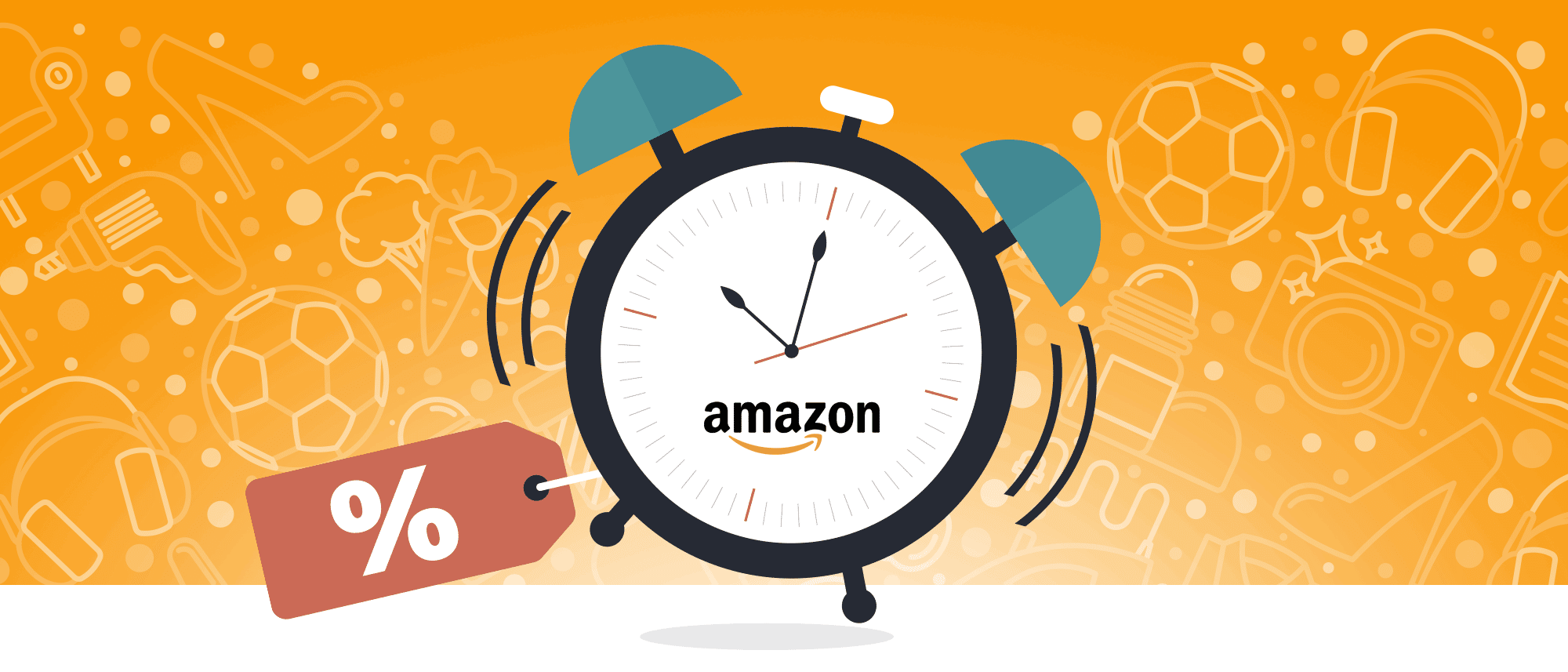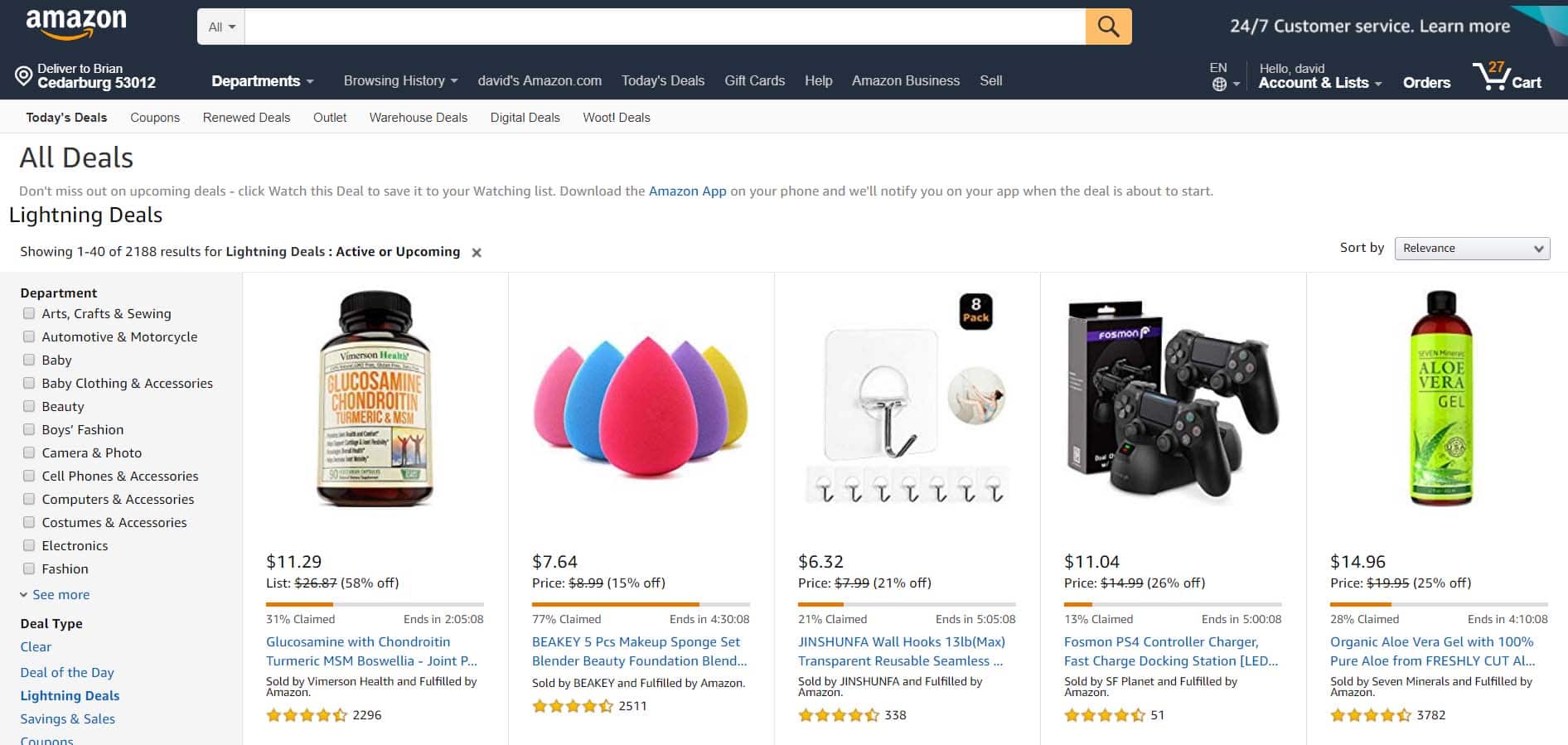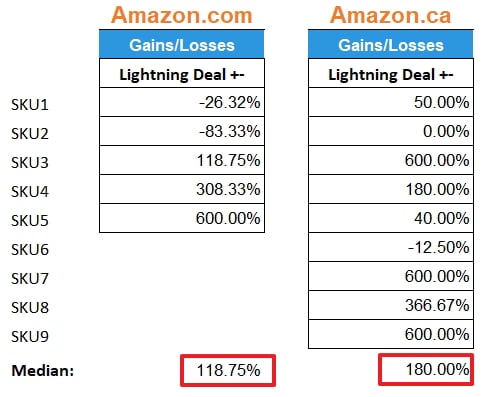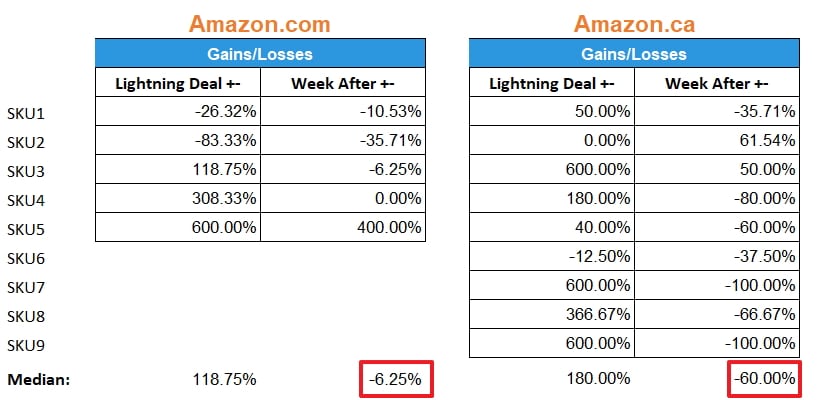Amazon Lightning Deals – Do They Work? (A/B Testing)

Within your Amazon Seller Central advertising tab is an option for Lightning Deals.
Amazon claims that, in exchange for a product discount of 15% or more and a fixed base cost, you can reap the benefits of having your item featured on the Lightning Deals page.
But do Lightning Deals work?
Let's find out.
What I Tested
I A/B tested multiple SKUs across Amazon.com and Amazon.ca marketplaces. The questions I wanted answers to were as follows:
- Do Lightning Deals result in a significant sales boost on the day that they run?
- Do Lightning Deals result in a significant sales boost after they are run?
- Is there a significant difference between Amazon.com and Amazon.ca marketplaces for Lightning Deals?
- What's the actual cost of running a Lightning Deal?
- Are Lightning Deals worth running?
I ran the Lightning Deals across 5 different SKUs (and 11 variations) across two marketplaces.
My products tend to be higher value and lower demand so some consideration needs to be taken into account for this effect. Results may vary for other products.
How Do Lightning Deals Work?
Running an Amazon Lightning Deal requires you to give some percentage of discount, normally 15% or more, in exchange for having your item featured on the Lightning Deals page as shown here. Amazon will also charge you a fairly steep fee to hold the Lightning Deal. For my products, it was $150 on Amazon.com and $20 on Amazon.ca
Lightning Deals run for 24 hours.
You can access Lightning Deals from within your Advertising Tab on Seller Central. You typically have to schedule these a minimum of two weeks in advance.
Do Lightning Deals Give a Sales Boost?
The first question I wanted to look at is: do Lightning Deals result in a significant sales boost on the day they are run? The answer was an emphatic YES. Lightning Deals do result in a significant sales boost the day that they are run.
Of the 15 SKUs I tested, all but three had a sales boost. The median increase in Amazon.com was 118.75% and on Amazon.ca it was 180%.
Do Lightning Deals Give a Sales Boost After?
There's a fairly steep cost to running Lightning Deals both in terms of required discounts and fixed costs. So, in order to be profitable, we would ideally like to see the Lightning Deal give a boost to sales afterward thanks to the added velocity.
Unfortunately, sales did not increase the week after running the Lightning Deal (compared to to the week prior to running the Lightning Deal). In fact, comparable weekly sales DECREASED for 11 of the 15 SKUs after running a Lightning Deal. The median decrease for Amazon.com was 6.25% and on Amazon.ca it was 60%.
Almost an equal number of sales that occurred when running the Lightning Deals was lost in the week after it was run. In other words, it seems we gave away a significant discount to buyers who would have otherwise purchased at full price.
How Much Do Lightning Deals Actually Cost?
Lightning deals aren't free. They cost a significant amount of money. But how much?
Generally, Amazon requires a minimum discount of 15-25%. In addition to this, there is a fixed cost which varies by the demand for your product. For my lightning deals, these ranged from $150 in the U.S. to $20 in Canada.
I looked at the fixed cost as a percentage of the product. So, for example, if there was a $150 fixed cost and 150 items were sold, I calculated this as a $1 discount and then applied this as a percentage of the product price.
The median total discount for Amazon.com was a staggering 45%. In Canada, it was 21.83%. This is a very significant discount. At 45%, I suspect most sellers cannot be profitable, and even at 21.83%, it makes profitability difficult for most sellers.
Amazon Lightning Deals: Amazon.com vs Amazon.ca
Lightning Deals on Amazon.ca had better results than on Amazon.com and required less of a discount. The average fixed cost on a Lightning Deal on Amazon.ca was $20 for me.
However, they also had a higher decline in sales in the days following the deal. Again, as discussed, any gain in incremental sales during the Lightning Deal seem to have been lost in the days following the sale.
This experience is fairly consistent with results from regular PPC advertising on .com vs .ca: Amazon.ca is significantly cheaper to advertise on than Amazon.com
Summary of Lightning Deal Conclusions
- Lightning Deals bring a significant boost in sales during the day of the deal
- Incremental sales resulting from the Lightning Deal appear to be equally lost in the subsequent days (i.e. there is no net gain from the Lightning Deal)
- The total discount required for Lightning Deals range from 21.83%-45.00%
- Lightning Deals on Amazon.ca have better results than on Amazon.com and require less of a discount but also have a higher decline in sales in the days following the deal
In conclusion, there was no net gain in sales from the Lightning Deals and it required us to add a 21.83-45.00% discount to our sales during the Lightning Deal.
These findings were not exactly surprising. In my experience of over five years of selling on Amazon through Seller Central and Vendor Central, Amazon's supplementary marketing programs are rarely worthwhile.
Have you experimented with Lightning Deals? What have your results been? Feel free to share in the comments below.








lightning deals are a medium-term investment. meaning in the first week or two you will not see any difference in rank or sales, but if you run lightning deals over a few weeks (usually 4-5) the organic ranking and sales will have a tremendous boost. I did it for a few of my products and it helped like no other thing. I also followed a few products that were doing organically okay, and after a few lighting deals, they started doing much better. they don’t help after one deal but after a few weeks, they make a big difference.
Hi Mitt – Thanks for the insight. I may looking into expanding the comparison time in the future.
Hi Dave,
Does the 7-day deal give you better traction? A week of good sales would be better for rankings than just 1 day — IF the sales were sustained. And of course, the 7-day deal is more expensive.
I haven’t A/B tested it exhaustively but I suspect result would be similar.
Thanks for the info! Good to know! Question: I dont understand what week you are comparing the sales from the week after to? Are you comparing it to the week of the lightning deal? Or are you comparing it to the week before the lightning deal? The year before same week? Thanks!
The week immediately before and after the lightning deal.
Great Article and very detailed analysis!
We have been thinking about running the lightning deal for our brand but I think we will hold off on it based on your result for now.
Thanks Jason!
Thanks for confirming the rumors! Interested to know of any impact to longer term KPIs such as KW rankings. ie does the boost in sales, even if it’s lost in the subsequent week, have any impact on KW ranking and session volume?
Also, was there any impact on PPC costs (CPC mainly) after the LD?
The KW ranking improvement would be, IMO, limited to the sales gain…and normally one day of good sales velocity doesnt change much long term.
Thanks for cutting through the garbage, Dave!
You’re welcome!